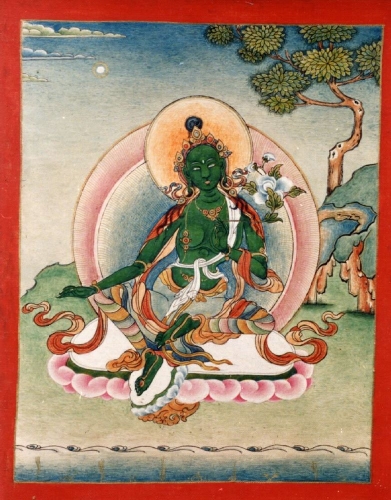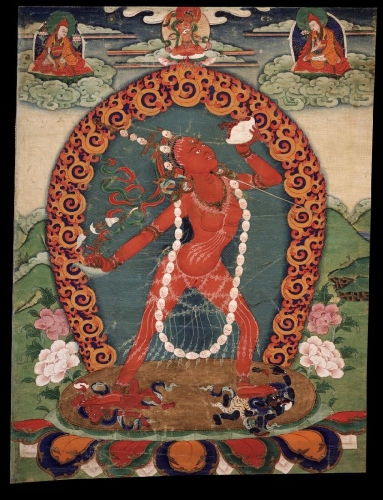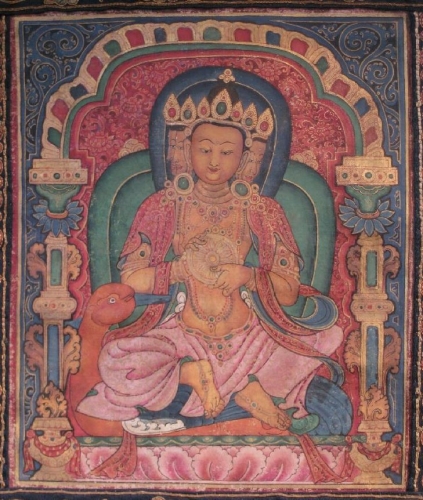Buddhist practice and Buddhist art have been inseparable in the Himalayas ever since Buddhism arrived to the region in the eighth century. But for the casual observer it can be difficult to make sense of the complex iconography. Not to worry—Himalayan art scholar Jeff Watt is here to help. In this “Himalayan Buddhist Art 101” series, Jeff is making sense of this rich artistic tradition by presenting weekly images from the Himalayan Art Resources archives and explaining their roles in the Buddhist tradition. Last week we explored Mandalas Part II, and this week we will move on to gods and deities.
Himalayan Buddhist Art 101: Gods and Deities in Tantric Buddhism
Gods and deities are a common feature of Tantric Buddhism. But who are they and where do they come from? Since deities make up a large percentage of the iconography in Tibetan Buddhist painting, sculpture, and most importantly, meditation practice, it is paramount to understand the answers to these questions. Initially the key thing to learn is that the terms “god” and “deity” are used interchangeably with no intended difference in meaning.
What exactly are gods and deities? There is probably no easy way to answer this question. The most direct route requires dividing the question into two topics. The first topic is a generally broad but inclusive definition of the word “god/deity” (in Tibetan: lha, yi dam) based on a general Tibetan understanding and a conservative dose of Western interpretation. The second topic is the enumeration of categories and the many traditional lists and subcategories of deities that are referred to in Indian and Tibetan Buddhist texts and traditions.
The Tantric Buddhist definition for “deities/gods” distinguishes between two very important and different types: worldly gods and beyond-worldly gods. Ordinarily most people refer to all deities as gods and all gods as deities, without distinguishing between worldly and beyond-worldly. In general a god is a supernatural being or presence that lives outside of our normal daily reality and who has the power to interact, for good or for ill, in our personal reality through spiritual connection, ritual, or a cause and effect relationship. Within Buddhism, these worldly gods are understood as sentient beings who have powers and life circumstances that are different from that of normal humans but occupy and move through the same wheel of existence—samsara—as humans do, based on the laws of cause and effect.
Examples of worldly gods are Brahma, Indra, Vishnu, and Shiva, along with all of the other less familiar Hindu characters. Included amongst those are the Guardians of the Four Directions, the local gods of the various Buddhist regions of Nepal, Tibet, and Bhutan, which include many mountain and regional gods. To the upper left is an example of the worldly god Brahma, with four faces, orange skin, and riding a large goose.

The beyond-worldly gods are believed to be unique to Buddhism and live outside of the wheel of existence. They are considered to be enlightened individuals or emanations of enlightened individuals. They are divided into two further categories: individual entities and emanations. Examples of well-known individual entities that have escaped from samsara are Shakyamuni Buddha, Medicine Buddha, and the meditational deity forms of Manjushri, Avalokiteshvara, Vajrapani and Tara (bottom right). Emanations originate generally from the five symbolic Buddhas (Vairochana, Amitabha, Akshobhya, Ratnasambhava and Amoghasiddhi) or from the Tantric meditational forms of Manjushri, Avalokiteshvara and Vajrapani. Examples of emanations are figures such as Hevajra, Chakrasamvara, Vajrayogini (top right), Kalachakra, Mahakala, and many others. The lists and subcategories of deities can be long and sometimes overlap. Next week we will look at some of the more common and well-known categories of Buddhist Tantric deities such as long-life, power, and deities of protection.
Thank you for subscribing to Tricycle! As a nonprofit, we depend on readers like you to keep Buddhist teachings and practices widely available.

